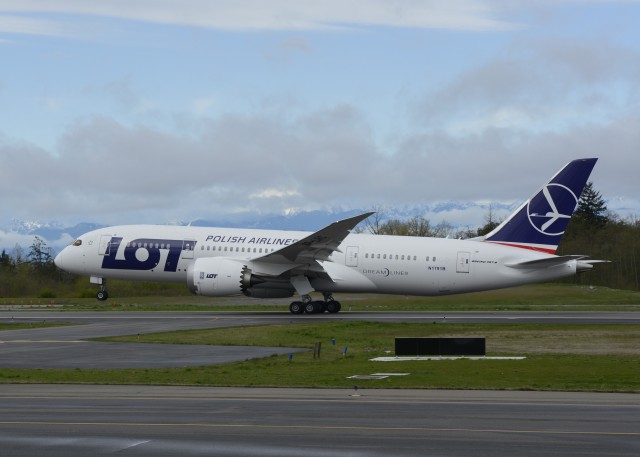
A Boeing 787 (L/N 86) painted in LOT livery takes off from Paine Field on April 5th. Image from Boeing.
On April 5th, Boeing conducted a test flight for the mostly grounded 787 Dreamliner. Line number 86, a Boeing owned 787 built for LOT Polish Airlines, departed Paine Field (PAE) for its first and final certification test for the new battery system. The airplane took off at 10:39 am Pacific Time and landed 1 hours, 49 minutes later at 12:28 p.m.
The 787 Dreamliner has been grounded since January 16th due to issues with the lithium-ion batteries that power the APU, but Boeing has been authorized to conduct a few test flights by the FAA, since the grounding.
“Our top priority is the integrity of our products and the safety of the passengers and crews who fly on them,” said Boeing Chairman, President and CEO Jim McNerney. “Our team has been working around the clock to understand the issues and develop a solution based on extensive analysis and testing following the events that occurred in January. Today’s approval from the FAA is a critical and welcome milestone toward getting the fleet flying again and continuing to deliver on the promise of the 787,” he said.
The test crew reported no negative issues and the data will be analyzed and submitted to the FAA. According to Boeing, once they deliver the data they will, “Stand ready to reply to additional requests and continue in dialog with the FAA to ensure we have met all of their expectations.”
When asked why Boeing chose L/N 86 with LOT livery for their test flights, Marc Birtel with Boeing Communications explained to AirlineReporter.com, “The airplane had already flown its first Boeing flight earlier this year and was already in the production flow toward delivery before the battery events occurred. As a result, we selected this airplane because of where it was at in the delivery process.”
According to the Seattle Times, the FAA could authorize the batteries as early as mid-month, but it would take a few additional months for them to start carrying passengers. Each of the 787s will need to be retrofitted and crews and employees will need to be re-trained.
Flight Global stated that fix teams have already been dispatched out to Narita, Japan to start modifying the 18 Dreamliners that are on the ground there as soon as they are given authorization. Along with the other ANA and JAL 787’s that are scattered around at different airports across the country. It is believed that it will take about four to five days to retrofit each aircraft.
It is expected that the Japan’s Civil Aviation Bureau (JCAB) (Japans version of the FAA), will follow the FAA’s decision to allow the Dreamliner to fly, whenever that might be.
UPDATE: Jaunted is reporting that United Airlines has the 787 back on their time schedule starting on May 31st. Also, Qatar is being a bit more optimistic and shooting for May 15th.
Brandon Farris and David Parker Brown contributed to this story.
[nggallery id=42]
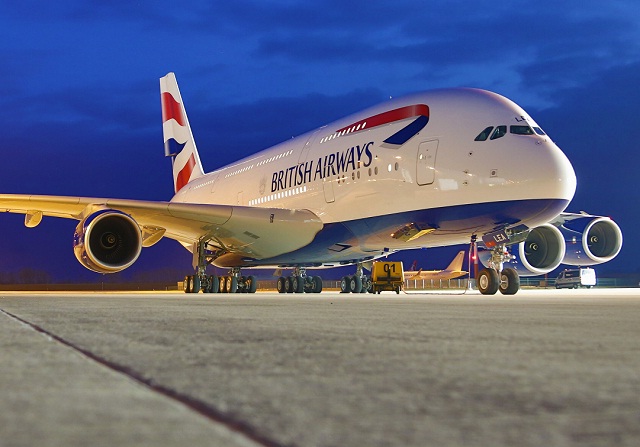
British Airways first Airbus A380 in Hamburg. Image from BA.
British Airways recently had their first Airbus A380 roll out of the paint hangar in Hamburg, Germany.
The airline is expecting to take delivery of their first double-decker airliner in July of this year and will first use the plane on short-haul routes for training and then on their London (LHR) to Los Angeles (LAX) route starting on October 15th. The second A380 will be placed on their LHR to Hong Kong in November (tickets for both flights are on sale now).
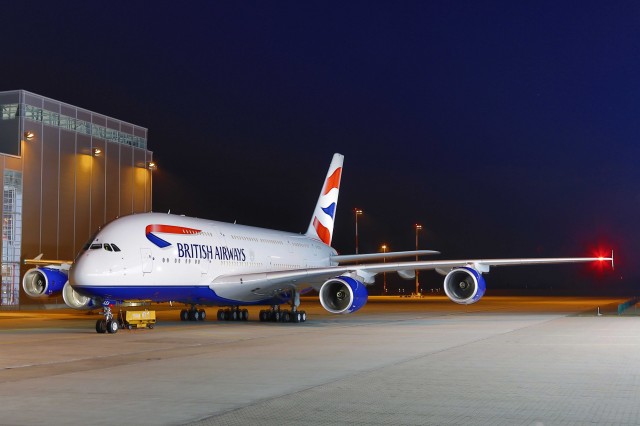
British Airways first Airbus A380 in Hamburg. Image from BA.
BA’s A380 will be configured to hold 469 passengers in four cabins: First Class (14), Club World (97), World Traveller Plus (55) and World Traveller (303).
The airline has 12 A380s on order, which are expected to all be delivered by 2016.
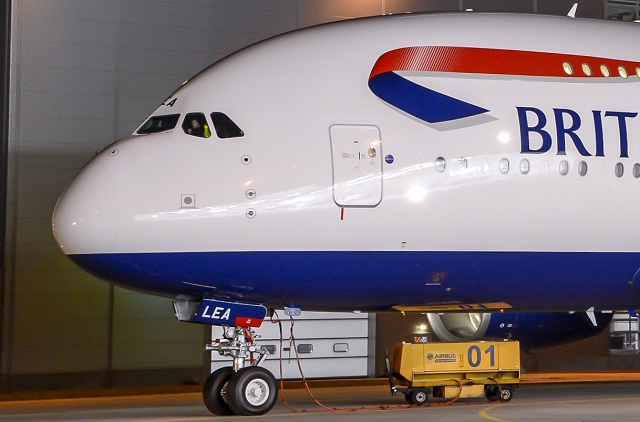
British Airways first Airbus A380 in Hamburg. Image from BA.
’œThis will be a very special premiere,” Keith Williams, British Airways’ chief executive, said. “The A380 is a great aircraft that has been developed with huge amounts of British engineering ingenuity. London and Los Angeles are two world-leading cities, and we are proud to be the first airline to connect them with the A380.’
Although the outside of the British Airways A380 is beautiful, the inside is not too shabby either:
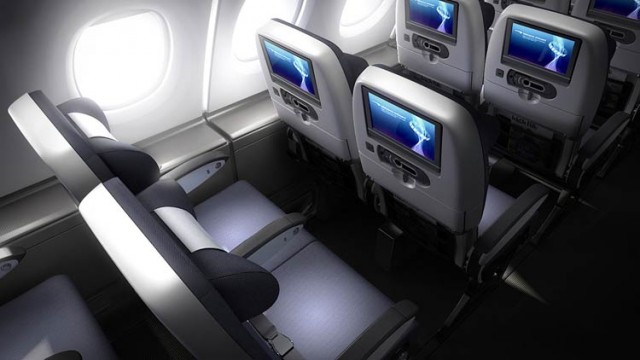
British Airways Airbus A380 World Traveller Cabin. Image by BA.

British Airways Airbus A380 First Class Cabin. Image from BA.

British Airways A380 Club World seat. Image from BA.
To learn and see more, check out British Airways special site on the Airbus A380.
 |
This story written by…David Parker Brown, Editor & Founder.David started AirlineReporter.com in the summer of 2008, but has had a passion for aviation since he was a kid. Born and raised in the Seattle area (where he is currently based) has surely had an influence and he couldn’t imagine living anywhere else in the world.
@AirlineReporter | Flickr | YouTube |

How many airline apps can you ID? CLICK FOR LARGER VERSION. Made up by Jason Rabinowitz.
Most airlines have smart phone apps right about now. Recently Jason Rabinowitz was looking through his and found some of the layouts… well interesting. Some match an airline’s brand, but others not so much. We decided to see if you can ID which app belongs to which airline.
This is not a huge contest and the winners will get shoutouts and some AirlineReporter.com stickers. Email your results (do not leave them in the comments) to da***@*************er.com — it is okay even if you do not get them all. You have until next Friday, when we will give you the answers.
You can leave questions, comments, frustrations in the comments. Game on.
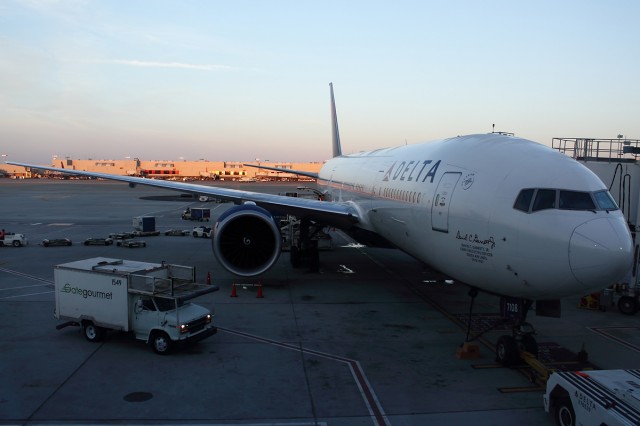
Delta Boeing 777-200LR in Atlanta. Notice the special signature on the nose. Photo by Brandon Farris.
I recently had the opportunity to fly from Atlanta (ATL) to Los Angeles (LAX) on Delta Air Lines flight 110, that was operated by a Boeing 777-232LR. Being the AvGeek that I am and having never flown on a 777 I just couldn’t turn this opportunity down.
I hopped on a red eye out of Seattle (SEA) that got into ATL at 05:30am giving me nearly 3 hours for my connection. I believe it literally took me maybe 20 minutes to get from where my SEA plane was parked in the B gates to gate F4 where I lay eyes on N708DN, a 2009 777-232LR that would be my ride back to the west coast. This aircraft is dedicated (with a special logo on the nose) to Delta’s former CEO David C. Garrett Jr who served for the airline from 1978-1987.
Being that I was at the airport so earl,y not many shops were open yet, so I mingled around the terminal where I saw a Boeing 767-432 arrive from Rio as DL60 and an Airbus A330-323 pushed back at 06:10am and depart as DL8860 to Saint Martin which was a surprise.
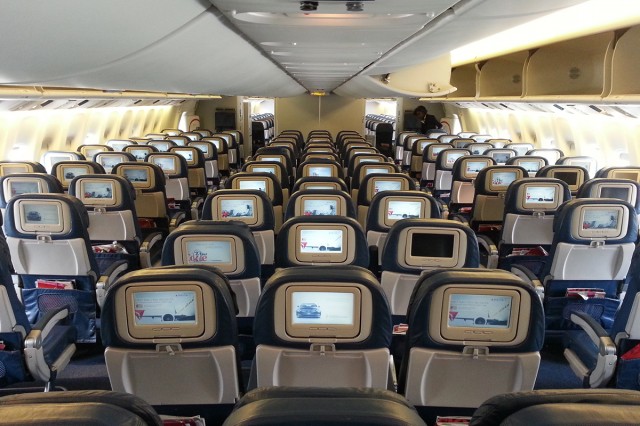
Delta configures their 777’s in a 3-3-3 layout. Photo by Brandon Farris.
Gate agents finally arrived around 07:00AM for our 08:10AM departure, at this point I was assigned 53E which is literally middle middle on this aircraft as it is a 3-3-3 configuration in the coach cabin.
It finally approached time to board, but were told that there was a slight delay with the cleaning crews onboard the aircraft and boarding would begin as soon as possible. Once boarding began I waited until the very end to get on since all I had was a backpack and wouldn’t require any overhead space.
Walking down the jetway the excitement began to settle in that I was about to step foot on my first ever 777 flight even if it was domestic, it is still a 777. By the time I boarded near the end, it didn’t take very long to get to my seat near the very back of the aircraft.
The time was now 0819 and our push-back began, only 9 minutes late so not too shabby. This was the part that I was most looking forward to; that howling growl start of those amazing General Electric GE-90’s as they spool up and come to life. I heard the first one start and it was like music to my hears. I know that I had the biggest and dorkiest smile/look on my face like a 5 year old. Yes I am in love with that howl!

Delta’s Economy in-flight entertainment. Photo by Brandon Farris.
Following the push-back, we begin our taxi out. The pilot came on the intercom and alerted us that we are number five for departure, 19 minutes after departing the gate the aircraft begins to turn on the runway. I was ready to feel the full 220,000lbs of thrust but since we were so light with only going to LAX the pilots really didn’t seem to throw the throttle that high. It didn’t seem very long for us to climb to our cruise altitude of FL400 as we headed west. I must admit that this was one of the quietest cabins I have flown on at cruise.
Now, I had the opportunity to check out the seats. They seemed very wide which I absolutely loved but at the same time each row is extremely narrow to where my knees were almost in the seat in front of me (I am 6’0″). I couldn’t imagine if someone had been sitting in front of me and reclining the seat. It would have crippled my space, in a long haul flight I definitely would consider upgrading to the front cabin if possible, but luckily this was a shorter flight.
The lack of leg space however was made up for with the ability to plug my phone in to charge and a seatback TV which had a very wide array of movies to choose from including ones that had just come out on DVD last week like Life of Pi, to classics like The Goonies.
I choose Lincoln, but since I was so tired, I fell asleep about 20 minutes into it and I actually took a nap for about 3 hours. When I woke up, the cabin crew was coming through with a final beverage service. As a part of the service, they offered three choices for snacks: pretzels, peanuts or the infamous biscoff cookies. This was a welcome change as I am just used to the standard AM or PM snack depending on when my flight was.

Flying on the 777. Photo by Brandon Farris.
At this point we were now about 40 minutes out from LA so I decided to get up and stretch a little and see if I could find a window to peak out somewhere and at least get a couple of pictures and was lucky to find that the cabin doors all have windows and was able to snap away for a couple of minutes. I also took this opportunity to visit the lav to find it was surprisingly very spacious.
But now it was time for me to return to my seat as we began our descent into LAX and was a fairly smooth approach. We landed on 25L and the pilots brought us in very gently before I was able to hear the roar of that GE-90 as the thrust reversers were kicked in. Following a short taxi we parked at the gate at 0957, three minutes early even after the late push.
Deplaning was brief, only being about 15 minutes from the back of the plane. I had the opportunity to talk to the pilots and was invited to make a brief visit to the flight deck before finally leaving the aircraft.
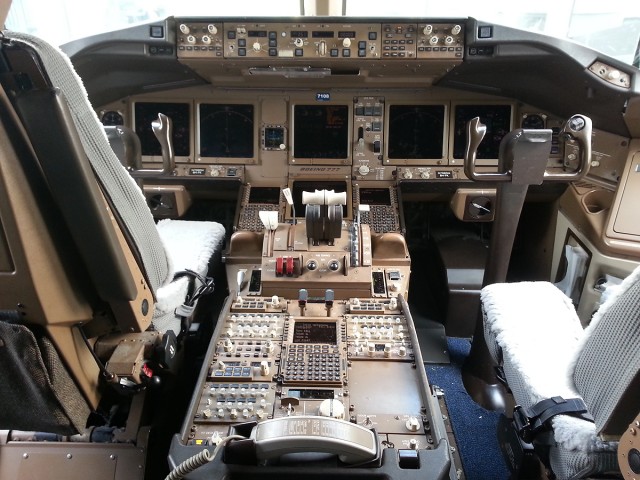
Flight deck of the 777. Photo by Brandon Farris.
Overall for this being my first time ever flying on Delta and the Boeing 777 I was extremely impressed on both fronts. The gate agents were extremely friendly which can be rare to find, especially at 0600 and 0700 in the morning. The inflight crew was great and was willing to answer any questions I had. It was nice to see such happy and helpful employees working for Delta after I have heard mixed reviews. Now to try and test out the 777 on a longer flight.
NOTE: Brandon covered the cost of this flight on his own and it was not paid for by Delta.
 |
This story written by…Brandon Farris, Correspondent. Brandon is an avid aviation geek based in Seattle. He got started in Photography and Reporting back in 2010. He loves to travel where ever he has to to cover the story and try to get the best darn shot possible.
@BrandonsBlog | RightStuffPhotography | Flickr |
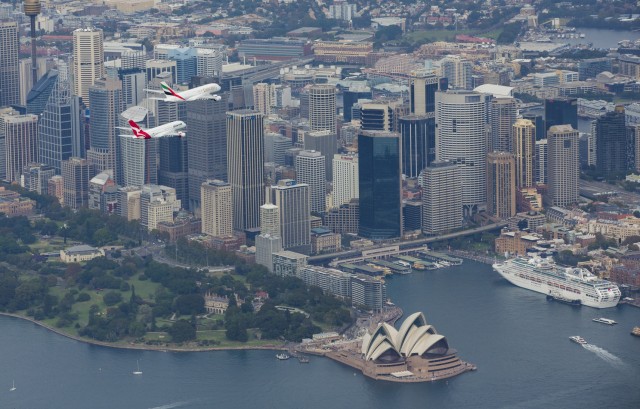
A Qantas and Emirates A380 Fly in Formation over the Sydney Opera House – Photo: Qantas Airways
On Easter Sunday in Sydney, many families spent time to calm down the sugar loaded children while the sun hides amongst the clouds in the southern autumn (fall). Yet in the sky, a unique event happened, never seen before.
To commemorate the start of the partnership between Qantas & Emirates the two airlines decided to hold a special event. At 10:30am, at 1500ft above the Sydney Harbor Bridge an A380 from Qantas, flew in formation with a second A380 from Emirates. This is the first time in aviation history that not only did two A380s flew in formation, but also two from different airlines.
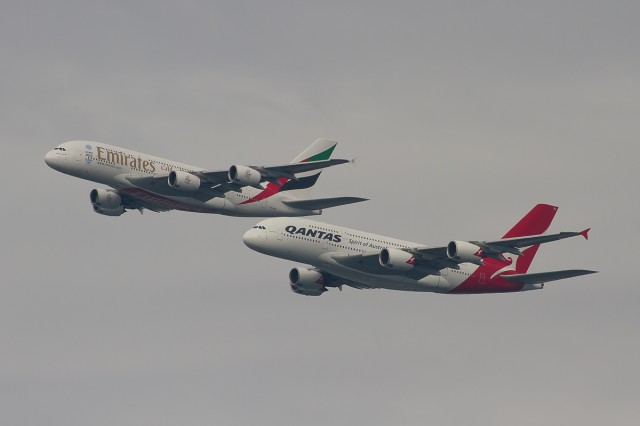
An Emirates A380 flies High and to the Right of the Qantas A380 – Photo: Bernard Proctor
’œThe sight of two of the world’s great airlines flying two of the world’s largest aircraft so close together over Sydney Harbor is a once in a lifetime opportunity,’ said Captain Green Chief pilot for Qantas.
Pilots from both airlines have conducted dozens of special simulator training sessions since January this year. Emirates pilots came to Australia earlier this month to conduct joint sessions in Qantas’ A380 simulator in Sydney and conducted several more practice runs over the past few days.
As VH-OQF (from Qantas) & A6-EDY (from Emirates) flew over Sydney Harbor they used the call sign ’œSeismic’ because Emirates President Tim Clark said ’œthe partnership between Qantas and Emirates will cause a seismic shift in global aviation.’
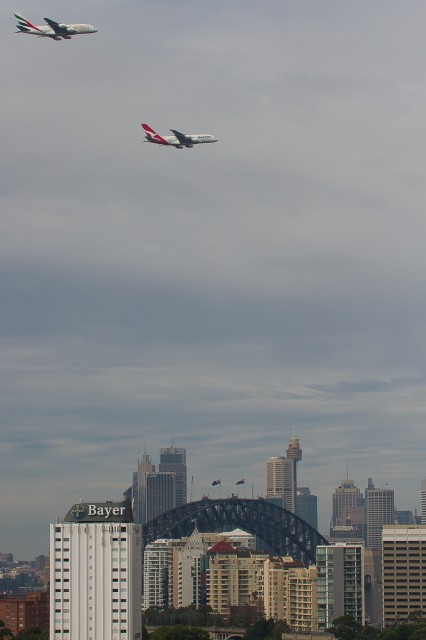
The two A380s fly over the Iconic Sydney Harbor Bridge – Photo: Bernard Proctor
The Qantas & Emirates partnership is game changing, as it sees the end of the dominant force on the ’œKangaroo Route’ from London to Australia via Singapore. That traditional route was maintained by an agreement between British Airways (IAG) and Qantas for over 15 years. Although Qantas & British Airways are oneworld partner airlines the joint agreement allowed them to coordinate pricing, services and flights between the UK & Australia. However when that agreement ended on the 31st of March, the Emirates partnership began.
With Qantas flying their A380s to London via Dubai, it allows Qantas customers access to 70 destinations in Europe with only one stop over the previous two. Emirates doesn’t come out of the deal empty handed, as they get access to the Qantas domestic network, which is by far the most comprehensive in Australia. Frequent flyer benefits and some on-board services have been aligned between the two carriers making this a true powerhouse to contend with.
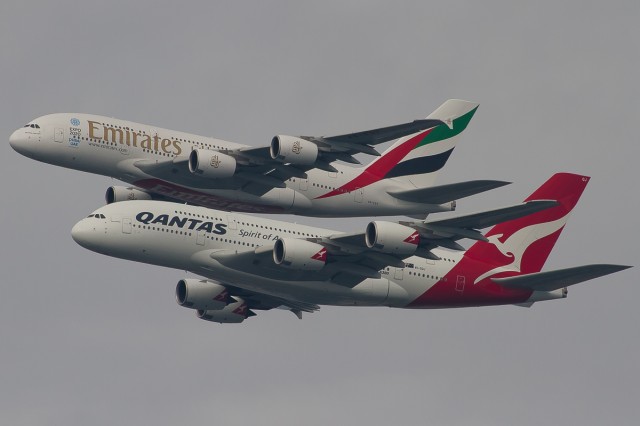
The First time two Different Airlines have flown in Formation – Emirates & Qantas – Photo: Bernard Proctor
I can just imagine standing by the shoreline on Sydney Harbor seeing these two large aircraft flying in formation and being surrounded by a stunned crowd of AvGeeks, tourists & locals. It is only too bad that the sun and blue sky were not out.
 |
This story written by…Malcolm Muir, Lead Correspondent.
Mal is an Australian Avgeek now living and working in Seattle. With a passion for aircraft photography, traveling and the fun that combining the two can bring. Insights into the aviation world with a bit of a perspective thanks to working in the travel industry.
@BigMalX | BigMal’s World | Photos |



















